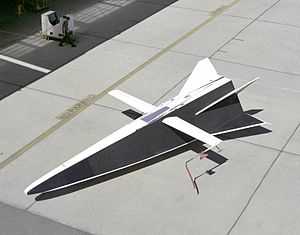NASA Hyper III
| Hyper III | |
|---|---|
 | |
| Role | Lifting-body remotely piloted vehicle |
| National origin | United States |
| Manufacturer | National Aeronautics and Space Administration |
| Designer | Dale Reed |
| First flight | 12 December 1969 |
| Primary user | NASA |
| Number built | 1 |
|
| |
The NASA Hyper III was an American unpowered full-scale lifting body remotely piloted vehicle designed and built at the NASA Flight Research Center at Edwards Air Force Base, California.[1]
Design and development
The Hyper III was designed to help in the M2 lifting body program, it had a flat bottom and sides, and a simple straight wing with no control surfaces [1] that was designed to simulate a pop-out wing that had been proposed for a re-entry vehicle. The Hyper III had twin fins and rudders canted at 40° from the vertical, and hinged elevons on the horizontal surface.[1] The landing gear was a fixed tricycle type, using spring steel legs from a Cessna aircraft.[1] It was fitted with an emergency parachute system and controlled by 5-channel radio link; instrument data was downlinked using a 12-channel radio.[1]
On 12 December 1969 the Hyper III was launched from a helicopter at 10,000 feet. It glided 5 km, turned round, came back and landed. After the three-minute flight it was not flown again as the Center cancelled the program.[1]
Specifications
Data from Jane's All the World's Aircraft 1973-74[1]
General characteristics
- Length: 32 ft 0 in (9.75 m)
- Wingspan: 15 ft 0 in (4.57 m)
- Height: 7 ft 6 in (2.29 m)
- Wing area: 35.41 ft2 (3.29 m2)
- Empty weight: 950 lb (431 kg)
- Gross weight: 950 lb (431 kg)
Performance
- Maximum speed: 173 mph (277 km/h)
- Stall speed: 69 mph (111 km/h)
- Range: 11 miles (18 km)
- Service ceiling: 12000 ft (3660 m)
See also
- Related lists
References
Notes
Bibliography
- Taylor, ed. (1973). Jane's All the World's Aircraft 1973-74. London, United Kingdom: Jane's Yearbooks. ISBN 0-354-00117-5.
|first1=missing|last1=in Authors list (help)
External links
| ||||||||||||||||||||||